Chapter Eight—
The First String Quartet, op. 7 (1904-1905)
Before the Quartet
After spending a year and a half in Berlin, Schoenberg returned to Vienna in the late summer of 1903 and began teaching classes in harmony and counterpoint at the school of Eugenie Schwarzwald and preparing piano arrangements for Universal Edition (Stuckenschmidt 1978, 78). Perhaps because of the move and these other activities, the early fall does not seem to have been a period of compositional productivity, but the late fall and early winter saw a flurry of songwriting and drafting (see table 7). It was at this time too that Schoenberg must have been revising Warnung for inclusion in his op. 3 (as discussed in chapter 4).
There is enormous technical and expressive diversity among the songs of 1903-4, greater than among the songs of the Dehmeljahr, 1899.[1] Perhaps the song that best adumbrates what Schoenberg was to achieve in the First Quartet is Verlassen, op. 6, no. 4, a powerful setting of a text by the naturalist poet Hermann Conradi.[2] The song is especially remarkable for its motivic concentration and for its contrapuntal, linear richness. On the largest scale the song is structured musically as an alternation between two thematic units—one cannot speak here of a single "theme"—which furnish virtually all the compositional material (ex. 8. Ia and b). The piano part begins as a strict one-measure ostinato with two basic motivic
[1] The songs Traumleben, op. 6, no. 1, and Natur, op. 8, no. 1, both from this period, will be treated briefly below in chapter 9 in the context of Neapolitan tonal relationships in the First Chamber Symphony, op. 9.
[2] Conradi (1862-90) was one of the pioneers of naturalism in Berlin in the mid 1880s. He was a contributor to an important volume of poems, Moderne Dichter-Charaktere, ed. Wilhelm Arent and Karl Henckell (Berlin: The Editors, 1885), in which Verlassen first appeared. In an introduction to the collection, Conradi calls for German poetry to abandon the tradition of folklike, sentimental lyrics and to broach topics more relevant to modern sensibilities. His plea is much like that of Karl Bleibtreu, made in the same year (see above, p. 66).
| ||||||||||||||||||||
components: rising chromatic steps unfolded in even quarter notes (w) and a figure containing a syncopated triplet (x). Above, the voice adds a third motivic idea (y), which shares or doubles the initial

The harmonic language is also, of course, affected by a texture so densely motivic that, as Webern said of op. 7, "everything is thematic" (Webern 1912; translated in Rauchhaupt 1971, 16). The opening is oriented around



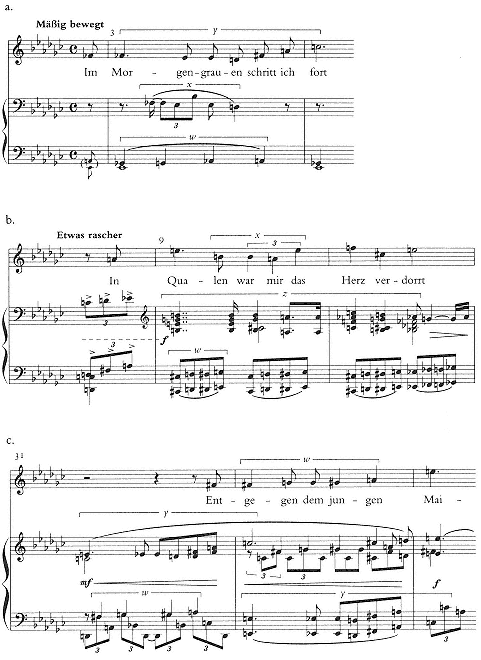
Example 8.1
Verlassen, op. 6, no. 4.
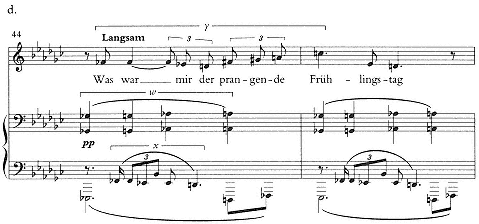
Example 8.1
continued
The intensity of the motivic working, the emphasis on invertible counterpoint at thematic returns, and the large role played by vagrant chords all mark Verlassen as a significant precursor of the D-Minor Quartet. A still more immediate precedent is another string quartet in D minor, which was to remain incomplete. This prior D-minor quartet, perhaps begun as early as 1901, but worked on most intensively in 1903-4,[3] is first alluded to by Egon Wellesz, who notes that in the summer of 1903 Schoenberg was working on "a string quartet which may be regarded as the predecessor of the D minor, Op. 7" (Wellesz 1925, 18). This must be a reference to the movement in D minor and a scherzo in F major, which are sketched intensively alongside op. 7 in the early portions of the so-called Sketchbook I, first used in the spring of 1904.[4] In addition to these sketches, there survives a fully scored draft of eighty measures of the opening movement, evidently begun as a fair copy (printed in SW A20: 219-25).
This torso provides important evidence of Schoenberg's compositional devel-
[3] Sketches for it appear in a pocket sketchbook used intermittently by Schoenberg between 1901 and 1908. See the discussion by Schmidt in SW B20: 279-84, who suggests (279) a starting date of 1901 for the fragmentary D-minor quartet because sketches for it are to be found among some for the Brettl-Lieder. Stylistically, however, the quartet fragment would seem to belong more to 1903.
[4] Schoenberg's sketchbooks from the period 1904-16, now in the archives of the Arnold Schoenberg Institute in Los Angeles, were first mentioned by Wellesz (1925, 19-20). They were described in greater detail in 1959 by Josef Rufer (who called them Sketchbooks I, II, and III, a practice I shall follow in this study), and in 1972 by Jan Maegaard (Rufer 1962, 126; Maegaard 1972, 1: 20-21). The most definitive and complete account, including detailed bibliographic descriptions, is that prepared by Schmidt for SW. See SW B3: 21-23 (Sketchbook I); B11/II: 1-5 (Sketchbook II); and B11/II: 6-7, 82-90 (Sketchbook III).

Example 8.2
Comparison of Fugue Subjects.
opment in instrumental forms between Pelleas und Melisande and the quartet that became op. 7. It is a slow, highly chromatic double fugue in which two subjects are presented independently and then combined.[5] Although no material was taken over directly from the earlier D-minor effort into op. 7, Wellesz was right to consider one a "predecessor" of the other. Schoenberg did incorporate a slow, chromatic fugue into op. 7—not at the opening, but as the transition to the second group of the first movement. In fact, the initial fugue subject of op. 7 bears certain striking similarities to the subject of the earlier D-minor fugue (cf. ex. 8.2a and motive b of ex. 8.3). Both are in duple dme and begin with a syncopated figure; both contain a pair of prominent downward leaps (minor sixths in the earlier fugue, diminished fifths in op. 7), followed by an upward semitone resolution.
The D-minor fugue subject not only anticipates the op. 7 transition; it also looks back to the most renowned nineteenth-century precedent for a fugal opening in a string quartet, Beethoven's Quartet in

[5] The fugue is analyzed in some detail, with transcriptions, by Schmidt in SW B20: 290-303. It is also discussed in Hattesen 1990, 167-90.
his op. 7.[6] The Beethoven quartet was obviously very much in his mind's ear as he worked toward, and on, op. 7 in the years 1903-4.
The first two bars of the earlier D-minor subject also hint at Schoenberg's characteristic interest in symmetrically arrayed tonal relationships. The dominant is decorated by the upper neighbor,






It is not clear either why Schoenberg abandoned work on the earlier D-minor quartet or what larger shape that work would ultimately have taken. Perhaps the massive double fugue came to seem too cerebral an opening for a quartet, even one by so committed a contrapuntalist as Schoenberg. In any case, in the spring of 1904, Schoenberg began work on the quartet that was to become op. 7 and was to occupy his energies on and off for a year and a half. In later years, Schoenberg would view this composition as representing a significant new direction in his musical development. He explained in 1949:
Thereafter [after Verklärte Nacht and Pelleas] I abandoned program-music and turned in the direction that was much more my own than all the preceding. It was the First String Quartet, Op. 7, in which I combined all the achievements of my time (including my own) such as: the construction of extremely large forms; greatly expanded melodies based on a richly moving harmony and new chord progressions; and a contrapuntal technique that solved problems offered by superimposed, individual parts which moved freely in more remote regions of a tonality and met frequently in vagrant harmonies.
RAUCHHAUPT 1971, 36
Although these remarks, as well as the D-Minor Quartet itself, would seem to signal a firm return to "absolute" instrumental music, Schoenberg would also allude frequently in later years to a "secret program" for op. 7 (see Bailey 1984, 130; Schmidt 1986, 230). When editing the quartet for SW, Schmidt discovered the outline of such a program on the inside cover of Sketchbook I; there can be
[6] See Schoenberg's notes for the first recordings of his own string quartets, prepared in 1936 (Steiner 1978, 132-33). Schoenberg also mentions Beethoven's quartet in typed notes for a lecture given at the University of Southern California in the 1930s.
little doubt that it refers to op. 7.[7] This program constitutes neither a poem nor a story line, as in Verklärte Nacht and Pelleas, but rather a succession of feelings or moods, which, as both Schmidt and Mark Benson have suggested (Benson 1987), can be matched with some precision to portions of op. 7, especially in the scherzo, for which the first sketches in Sketchbook I are marked "Neues Leben fühiend," a phrase that also appears as part of the program outline.
Large-Scale Form and Thematic Process
Although the secret program is obviously not without significance for an understanding of op. 7, the real importance of the work lies in its relationship to, and transformation of, the absolute instrumental tradition of the eighteenth and nineteenth centuries. The D-Minor Quartet was unquestionably Schoenberg's most thoroughgoing attempt up to that date to compress and interweave into a continuous composition the standard three or four movements of an instrumental cycle, or, as he himself put it, "to include all the four characters of the sonata type in one single, uninterrupted movement" (Rauchhaupt 1971, 36). Schoenberg's quartet goes much further in this direction than Richard Strauss's tone poems or earlier nineteenth-century predecessors like Schubert's "Wanderer" Fantasy, Liszt's B-Minor Piano Sonata, and Schumann's Fourth Symphony. In each of the latter three works, the movements or sections succeed each other without pause (or with only a short pause); in each, there are clear thematic relationships between the movements; in each, the larger scheme is modified according to principles of sonata form, in that the first movement recapitulation is suppressed and its function largely taken over by the finale. Schoenberg does all this and more.[8]
The overall form of Schoenberg's D-Minor Quartet is outlined in table 8. The following description corresponds closely to Schoenberg's own prose analyses, which, significantly, invoke only the thematic dimension of "sonata form," not
[7] The program is transcribed in SW B20: 109-10, and in Schmidt 1986. It also is included, in the original German and in English translation, in the booklet accompanying the 1987 reissue on compact discs of the La Salle Quartet's Neue Wiener Schule: Schoenberg, Berg, Webern (DG 419 994-2). This booklet is a reformatted and in some respects abridged version of Rauchhaupt 1971; the recently discovered program for op. 7 appears on pp. 18-19 (German) and 236-37 (English).
[8] In his "Notes" of 1949, Schoenberg also suggests that the first movement of Beethoven's Eroica Symphony served as an important "model" for the "great expansion" of op. 7 (Rauchhaupt 1971, 36, 39). This tantalizing remark refers, I think, not to any large-scale formal principles, but to techniques of thematic and motivic development. Dika Newlin, taking Schoenberg at his word, has attempted to demonstrate specific similarities between some of the Eroica themes and those of op. 7 (Newlin 1978, 227-29); the analysis seems contrived and seems also to misintepret the broader kind of "modeling" to which Schoenberg was probably referring. Despite Schoenberg's mention of the Eroica as specific model, I feel that attempts to find any one-to-one relationship are misguided. (At least up to this point I have not seen or read any persuasive accounts.)
| ||||||||||||||||||||||||||||||||||||||||||||||||
the harmonic one.[9] The first "movement" is comprised of a sonata-form exposition, development, and varied recapitulation. Then follows a full-fledged scherzo-trio-scherzo. The varied reprise of the scherzo functions as a continuation or resumption of the development, which begins with thematic material from the scherzo and then (at H ) takes up material from the first group of the first movement. The development leads into a more literal recapitulation of the main theme on the tonic, then a dramatic "liquidation."
A long fermata marks the principal large division of the quartet. The tripartite slow movement opens with essentially new thematic material, which is gradually permeated by recollection of secondary themes from the first movement. This process is analogous to the infiltration of the scherzo reprise by first group themes in the first half of the quartet. Just as that process led up to recapitulation of the first group, so this one leads (at L 52) to a recapitulation of the second group. The rondo finale theme is fashioned as a transformation of the slow movement theme; the contrasting episodes are all built from earlier themes. The coda, based on the opening and transition theme, functions as a conclusion to both the larger four-movement plan and the individual sonata-form plan.
Neither a diagram nor a verbal synopsis can do justice to the richness of op. 7, a work that, as Adorno claimed, "down to its last note . . . created an entirely new level of thematically coherent chamber-music composition" (Adorno 1981, 157). Something of the thematic-formal process that seems to generate the larger structure before our very ears can be sampled across the 300-measure segment comprising the transition, second group, first development and recapitulation, and scherzo. The transition is one of the least tonally oriented passages in the entire quartet (and in Schoenberg's music up to this point). A fugato based on a highly chromatic subject, it is almost pure counterpoint, pure "theme." First stated in full at the second entry, by the second violin, the subject has three related components or motives, labeled a, b, and c in ex. 8.3. (As will be shown below, in an examination of the sketches, these labels are in fact Schoenberg's own.) Subject b freely inverts the opening leap of a, then continues with a similar ascent
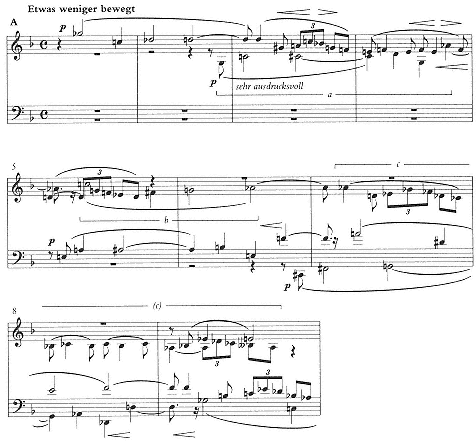
Example 8.3
First String Quartet, op. 7, transition.
through two half-steps. Subject c, rhythmically more animated, begins like a diminution of b, with the downward leap of a diminished fifth and ascent of a half-step. Its second measure contains what is to become an important syncopated figure oscillating within a half-step. The fugato opens with the b subject in the first violin; all subsequent entries employ a, b, and c in order.
The main theme of the second group of the exposition (ex. 8.4a) is derived directly from the transition material. The principal melodic line, in the first violin, is a rhythmically augmented version of the oscillating, syncopated seconds of motive c. The bottom part, at first played in parallel thirds by the viola and cello, takes over the first four notes and the rhythm of motive b (at a different transposition). In the continuation of the second group, Schoenberg fashions a magical transformation in E minor of the c -derived figure, which is now given a
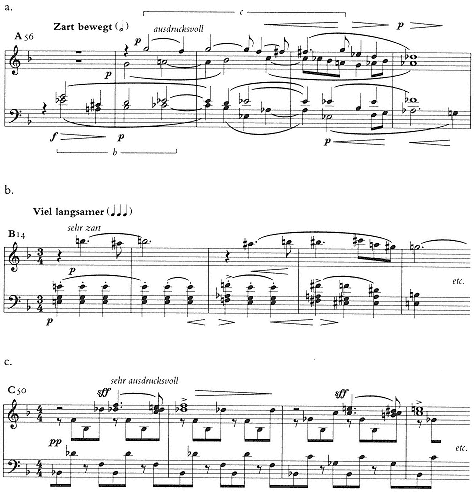
Example 8.4
First String Quartet, op. 7, second group and transformations.
pulsating homophonic accompaniment (ex. 8.4b). In the first recapitulation, this theme appears in yet another homophonic transformation, now(in


Example 8.5
First String Quartet, op. 7, scherzo.
basic material is less "developed," less pulled apart, than it is placed, more or less intact, into a new rhythmic, textural, and harmonic context.[10] The transformations in op. 7 show clearly how Schoenberg seeks to link his work with nineteenth-century models, despite a style that is at other moments relentlessly developmental and modern.
The final part of the first recapitulation is occupied by energetic working of the transition theme and an extraordinary modulation from the dominant of F to that of





The First Group: Thematic Aspects
In the discussion up to this point, I have concentrated on what might be called the higher-level thematic process, which shapes the broader segments of the form. The quartet is as intensely "thematic" on the more local level, as can be seen in the first group (mm. 1-96; first portion reproduced in Appendix ex. Q). The later Schoenberg, even the composer of the First Chamber Symphony of
[10] On the basic distinctions between thematic transformation and development, see Frisch 1984, ch. 2, and Friedheim 1963, 13–14.
1906, would undoubtedly have deemed excessive the first group's duration of two and a half minutes and the numerous varied repetitions of the main theme; but for the Schoenberg of 1904, such breadth was necessary to assure the comprehensibility and memorability of the basic thematic material of the quartet.
The structure of the first group is a fascinating hybrid or interweaving of what might be called strophic form, in which the main theme is subjected to successive variation, and ternary form, which has a contrasting middle section. (We have seen how Schoenberg used ternary form for the first group of the first movement of his D-Major Quartet [chapter 2] and how he modified it for many of the thematic statements of Verklärte Nacht [chapter 5].) Emphatic statements of the main, or A, theme are placed like pillars at roughly thirty-measure (or, in real time, fifty-second) intervals: A (m. 1). A' (m. 30), A" (m. 65). This structure comprises the strophic aspect of the first group. But A' also serves to some extent as a contrasting middle section in that A and A" begin firmly in the tonic, D minor, while A' contains statements of the theme outside (literally, around) the tonic, in


Another ternary aspect of the structure of the first group is suggested by the contrasting (but related) material beginning at m. 14, in the key of

As was pointed out long ago by Berg in his renowned essay on Schoenberg's quartet, the opening "theme" of op. 7 actually consists (as in the song Verlassen) of three separate lines, which come to be treated independently (Reich 1965, 199).[12] This opening thematic complex (Appendix ex. Q) extends thirteen measures and consists of two related segments, which we can call x (m. i through beat 3 of m. 8) and y (beat 4 of m. 8 through 13). (Measures 7-8 are really transitional, serving both to continue elements of x and to introduce the sixteenthnote motion that is characteristic of y.) In the areas of phrase structure and metricrhythmic manipulation, this thematic complex goes well beyond opp. 4 and 5.
Berg analyzed what I call x1 as comprising two phrases of two and a half mea-
[11] This embedding of formal structures within one another is discussed by Michael Cherlin in a stimulating unpublished study, "Formal Problems in Schoenberg's First String Quartet," prepared as a seminar paper at Yale University in 1980. I am grateful to Professor Cherlin for sharing his essay with me.
[12] Berg's essay, "Warum ist Schönbergs Musik so schwer verständlich," first appeared in 1924 in a special issue (Sonderheft) of the Viennese journal Musikblätter des Anbruch, devoted to Schoenberg (Arnold Schönberg zum fünfzigsten Geburtstage). It has been translated three times: in Music Review 13 (1952): 187-96; in Reich 1965, 189-204 (from which my citations are taken); and in Rauchhaupt 1971, 20-30.

Example 8.6
Berg's analysis of the main theme from Schoenberg's First String Quartet, op. 7 (from Reich 1965, 191).
sures each (ex. 8.6); he pointed with admiration (as his teacher Schoenberg would do to themes in Brahms) to Schoenberg's avoidance of the conventional two- or four-measure unit. In fact, the structure is more intricate than Berg suggests. The basic phrase cannot be said to end in midair on the D of m. 3, as Berg's parsing suggests, but on the low E that follows. Such an interpretation—of the E as the conclusion of the phrase—is borne out by the slur linking the D and E (in the real score) and by the diminuendo across beats 2–4 of m. 3.[13]
And yet there is an important element of accuracy in Berg's analysis. Classicalromantic practice would lead us to expect a second phrase beginning on the low E, the note that corresponds in duration and in register to the D of m. I. A second or consequent phrase built as a sequence of the first and beginning on the supertonic degree is a time-honored device for opening themes (for example, the first Allegro theme of Beethoven's First Symphony, or of Brahms's Second). In his cheeky rewrite of Schoenberg's theme, intended to smooth out the irregularities, Berg puts it in exactly such a form: two two-measure phrases, the second beginning on the second degree (Reich 1965, 193). (Even here, however, there is overlap, since the E is still heard as conclusion to the first phrase.) Schoenberg is clearly playing upon such an expectation here: the note E remains tantalizingly ambiguous, both an ending and a beginning. In this sense it functions like section A' of the first group, looking both backward and forward.
Each of the two lower elements of the theme falls into a phrase structure (and relationship to the notated bar line) different from x1 . The viola part, x2 , unfolds in regular one-measure units. The bass, x 3 , consists, like x 1 , of two essentially sequential phrases, but the second phrase (up a minor third from the opening pitch D) begins in beat 2 of m. 4, well after the beginning of the second phrase of x1 . Thus, the second phrases of 1 and x3 lie differently with respect to each other than did the first phrases.
By m. 6 the original metrical alignment of x1 is restored: the dotted figure DE is now in its original position on the fourth beat (like the

[13] For further discussion of the structure of this theme and of its genesis as reflected in the sketches for op. 7, see Frisch 1984, 165-69.
7 all parts begin clearly and emphatically on the notated downbeat with what is the first real development of x material. As Berg plausibly suggested, the top line here is like a compressed version of x1 (Reich 1965, 192). Now the elusive pitch E is fully integrated into the theme. The bottom line is clearly a variant, in dotted rhythm, of the portion of x3 that descends from the

After this measure, Schoenberg builds to the climax of the A theme by introducing essentially new material (hence y). Each of the three elements is distinct from what has preceded it: the top line (y1 ), in which an essentially stepwise descent (

Unlike a conventional contrasting B section in a ternary group, B begins in m. 14 almost as if resuming the development of x, which has been interrupted by y. The top part seems to pick up rhythmically in the second measure of x1 as does the bass in the second measure of x3 . The viola line has the rhythm and the tremolo of x 2 , but the pitch structure of x3 . Just as the first half of B is a recollection or development of x, so too its continuation in mm. 19-24 is clearly based on y. The chromatically descending line y1 y is now augmented to quarter-note triplets; the sixteenth-note quintuplets of y2 y have become eighth-note ones. Only at the very end of B, with the "etwas langsamer" theme of m. 24, does Schoenberg introduce genuinely contrasting material (z); this, however, gives way almost immediately to A'.
In A' the original x returns, but with its outer parts inverted: x1 is now the bass, x3 the melody. In its eighth measure, the restatement of x veers away from its initial form into an extended contrapuntal development of material from A (x,y, and z) y and B. The arrival of the A theme in D minor at m. 65, with its components in their original position (x1 on the top, x3 on the bottom) signals the real return within the first group; because of the extensive development that has preceded in A', the return is especially forceful. It leads to a full liquidation of A material.
The First Group: Harmonic Aspects
The thematic process of the first group rides on the surface of, and of course helps to generate, a chromatic harmony that is no less volatile. In his 1924 essay Berg presents a harmonic skeleton of the first ten measures of op. 7 in what he calls "chorale style" (ex. 8.7). He attempts to show that despite the profusion of chords that occurs within a short space, all represented in half notes in his example, "there is no single sonority, not even on the unaccented semiquavers
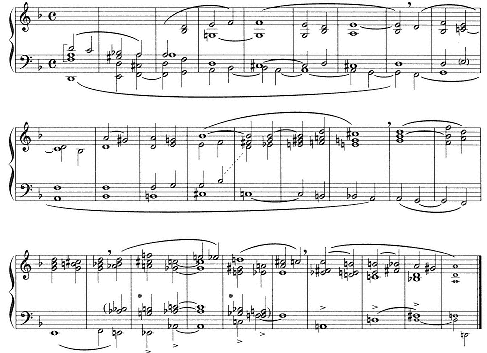
Example 8.7
Berg's "chorale" or harmonic reduction of the first theme of Schoenberg's First String Quartet, op. 7 (from Reich 1965, 197).
[eighth-notes] of these ten quartet bars, that cannot be immediately clear to any car educated in the of the last century" (Reich 1965, 198). As Christopher Wintle has shown, many of the verticalities in Berg's chorale can be explained along the lines of Schoenberg's own Theory of Harmony as chromatic alterations of certain basic chords (Wintle 1980, 52-55). And although, as Wintle also suggests. Berg's harmonies are sometimes dubious representations of what seems actually to be happening in the music, the chorale nevertheless offers a good starting point for an assessment of the local-level harmonic component of op. 7.
One of the striking things about the quartet-and this is readily apparent at the opening-is the avoidance of functional dominants on the small scale and the concomitant pervasiveness of vagrant harmonies. Berg's chorale displays a dominant-seventh harmony across (his) mm. 5-7; although the harmony is somewhat obscured by the motion of the voices, it is explicit in the first half of
m. 6 and throughout m. 7. In the actual piece, this dominant is even less apparent, and less structural. Although the A in the bass on the last eighth note of Schoenberg's m. 2 supports a


The harmonic goal of the first phrase is not the elusive dominant, but the



Across the A portion of the first group, Schoenberg's strategy seems to be to increase the level of dissonance and chromaticism progressively. The






The two-beat silence of m. 10 is shattering in effect: the musical discourse seems paralyzed or frozen by the disorienting harmonic-thematic spiral of theme y. The shock is then intensified, rather than dissipated, by the sequential repetition of y up a major third (and now fortissimo). The use of exact sequence (it is exact up to m. 12) is rare in Schoenberg's works after 1900, and is especially strik-
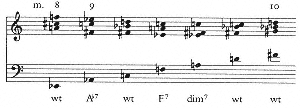
Example 8.8
First String Quartet, op. 7, alternation of whole-tone and seventh chords in mm. 8–10.

Example 8.9
Derivation and resolution of six-note whole-tone chord, from Schoenberg 1978, p. 392 (ex. 323).
ing in view of the negative opinion he often takes of it in his writings (see, for example, Schoenberg 1975, 129-31). Here the sequence seems specifically intended to exaggerate or prolong the disruption represented by y.
The combination of vagrant harmonies with fifth motion in the bass is reminiscent of certain works of 1899 and 1900, especially the song Jesus bettelt from op. 2 (see chapter 4) and Tove's"Du sendest mir einen Liebesblick"from Gurrelieder (see chapter 6). However, the whole-tone complex now plays a greater role, and does so in a way that has important implications for Schoenberg's compositional language in 1904-5. In op. 7, Schoenberg does not treat the whole-tone scale/chord as a purely symmetrical, rootless phenomenon. It is used less to weaken or loosen tonal implications than to intensify chromatic and vagrant harmonies. By resolving the whole-tone harmonies of mm. 8-9 emphatically up by fourth, as if they were dominant chords, Schoenberg seems to stress their functional aspect.
It is essential in this context to consider Schoenberg's discussion of whole tones in Theory of Harmony, where a chord containing all six notes of the whole-tone scale is derived from a dominant ninth, by "simultaneously raising and lowering the fifth"(Schoenberg 1978, 392). This ninth chord is then resolved by fifth, like a normal dominant, as in ex. 8.9. This resolution can be compared with those in theme y of op. 7, as shown in the first four chords of ex. 8.8. (In ex. 8.8 the
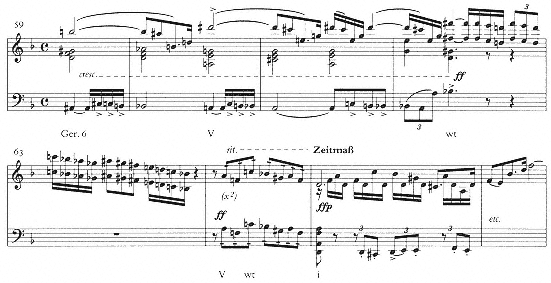
Example 8.10
First String Quartet, op. 7, transition to return of main theme (A").
whole-tone chords are represented with four, not six, notes; but, as suggested earlier, all six notes of the scale are in fact sounded in the music, where the effect and function are similar to Schoenberg's Theory of Harmony example.) This rootoriented view of even the most vagrant chords is fully characteristic of Schoenberg. As with any chord discussed in Theory of Harmony, he stresses the way in which the whole-tone sonorities are to be resolved and linked with other harmonies. In this respect he contrasts his own early compositions with those of his contemporaries:
Debussy uses this chord and scale more in the sense of impressionistic expressive devices, somewhat as a tone color (so does Strauss in Salome); but they entered my work more for the sake of their harmonic and melodic possibilities: the chords for the sake of their connection with other chords, the scale for the sake of its peculiar influence on the melody.
SCHOENBERG 1978, 393
The role of the whole-tone complex in op. 7 as intensification, rather than dissolution, of diatonic-chromatic relations is reinforced at the transition to A" in the first group (ex. 8.10). After the imitative statement of the main theme beginning on

chord like a German sixth on




The whole-tone scale breaks off abruptly in m. 63; the reappearance of the main theme in D minor is preceded in m. 64 by a transitional measure identical with the first measure of x2 (see ex. 8.10). Schoenberg's use of this thematic fragment as a transition is a masterstroke, for it serves genuinely to mediate between the preceding whole-tone scale and the subsequent D-minor return. Whole-tone elements are still present in the


Here we might do well to glance back at Berg's chorale (ex. 8.7), where the harmonic reduction of the second half of Schoenberg's m. 1 (the first half of m. 2 in the chorale) reveals a whole-tone chord of the French sixth type, with E in the bass. Berg's harmonic entity may not at first seem an accurate rendering of Schoenberg's music, since it freezes into a fictional simultaneity two pitches,


The whole process is a splendid example of the intimate, reciprocal relationship between the vertical and horizontal dimensions-between "harmony" and
[14] The relation of the whole-tone chord of m. 2 of Berg's chorale to that of m. 23 has been pointed out by Wintle (1980, 54).
"theme"—in the quartet. What begins as an apparently linear, thematic detail in the viola part of m. 1 becomes a harmonic element in the whole-tone sonorities of mm. 8-9, then evolves back into the former role with the whole-tone scale of mm. 62-63.
Sketches: The Genesis of Op. 7
Schoenberg was occupied with the D-Minor Quartet intermittently for over a year and a half, from the spring of 1904 to the fall of 1905. More sketches survive for this than for any other early work, and they bear separate consideration here for the richly detailed and suggestive—if not always easily decipherable—picture offered of how Schoenberg planned his most ambitious large-scale instrumental work to date. Perhaps the strongest impression gained from such a study is how intensively Schoenberg labored to create the dense web of thematic interconnections—what I have above called the large-scale thematic process.
With the exception of a handful of loose leaves, all the extant preliminary graphic activity for op. 7 is contained on almost 100 pages in the two sketchbooks (I and II) that Schoenberg used consecutively in the years 1904-6. In the critical report for the D-Minor Quartet in SW (B20: 1-13), Schmidt divides the material in the sketchbooks into two categories, a "first fair copy" (erste Niederschrift) and "sketches" (Skizzen). The former constitutes a nearly complete full-score draft of the work, although not a continuous one, since the music is distributed widely over the sketchbooks and sections are connected by Schoenberg with numerous "VI-DE" cross-references. (The final fair copy of the score, which served as Stichvorlage, is a separate autograph at the Library of Congress, dated 29 September 1905 at the end.) The latter category includes every other kind of musical jotting not part of the first fair copy.
On the whole, the sketchbooks bear out Schoenberg's own testimony about the composition of the quartet. In the essay "Heart and Brain in Music" (1947), he noted, "I personally belong to those who generally write very fast, whether it is 'cerebral' counterpoint or 'spontaneous' melody" (Schoenberg 1975, 55). He implies that this was the case with the composition of the D-Minor Quartet: "Some forty years ago I was composing my First String Quartet, Op. 7. Usually taking morning walks, I composed in my mind 40 to 80 measures complete in almost every detail. I needed only two or three hours to copy down these larger sections from memory" (ibid., 61).
These "larger sections" would correspond to what Schmidt has called the first fair copy (although neither he nor Schoenberg accounts for why these sections appear so scattered, and their sequence so jumbled, in the sketchbooks). But in addition to these segments, the sketchbooks contain several smaller fragments, usually of only a few bars, in which Schoenberg is clearly engaging less in active
| ||||||||||||||||||||||||||||||||||
"composition" than in reflective or exploratory work. Following Alan Tyson's term for certain of Beethoven's similar jottings, we may call these "concept" sketches (Tyson 1970, 68-69), although it is important to note (and will be shown) that Schoenberg's concept sketches tend to appear in coherent groups, while Beethoven's are usually more isolated. If we assume that the order of the material as set down in the sketchbooks for the most part represents the order in which Schoenberg conceived or drafted it—and I think it is reasonable to do so, since the books were bound before any entries were made—then a fascinating sequence of creation emerges. Table 9 shows the position of these concept sketches within the sketchbooks and their relation to the formal scheme outlined in table 8.[15] Pages with the most significant concept sketches are indicated in italics. These represent what I believe to be the "crisis" points in Schoenberg's draft-
[15] The dates given in table 9 are taken from Schoenberg's own annotations in the sketchbooks. When referring to a particular sketch, I shall for the convenience of the reader provide a reference to the transcription in SW, including (in brackets) the "S" number assigned by the editor, Schmidt, to each sketch. My own readings occasionally differ in details from Schmidt's.

Example 8.11
First String Quartet, op. 7, sketch for scherzo theme, in Sketchbook I, p. 31.
ing of the quartet, moments at which the generally smooth flow of composition was interrupted.
After working out much of the first group on ¼-17 (Sketchbook I, pp. 4-17), Schoenberg set aside the quartet to work on other projects, principally the songs that were to become op. 8.[16] Some fourteen pages later, he returned to op. 7, but did not, as we might expect, pick up where he left off, in the first group. He began instead to sketch the scherzo theme, well in advance of its eventual appearance. The theme appears in short score in the key of

Schoenberg attempted no larger draft of the scherzo at this point, but began instead to work immediately on the second group, another step backward to his previous stopping point. The first concept sketches appear in short score on the following page, 1/32;[17] the sketches for the second theme are partially transcribed in ex. 8.12 (SW B20: 52-53 [S22-23]). In its initial form, ex. 8.12a, the theme makes no apparent reference to motives b and c; the principal melody and the bass part lack the syncopation characteristic of these motives. Schoenberg thus seems to work more from a harmonic skeleton than from a fully thematic conception. Directly beneath this sketch, however, Schoenberg in effect "thematicizes" the same passage (ex. 8. 12b). The top line is now much closer to c; the bass syncopation, which derives from motive a, is added in the margin of the sketch leaf and thus appears to be an afterthought. It was most likely tacked on some-
[16] This would have been in mid July 1904. In a letter to Oskar Posa written on 13 July, Schoenberg notes that he has begun a new orchestral song and has set aside the quartet for the time being: "Mein Quartett ruht. Vielleicht komme ich aber doch noch dazu" (cited in Szmolyan 1974, 193.)
[17] A facsimile reproduction of this sketch page appears in Frisch 1988a, 300.
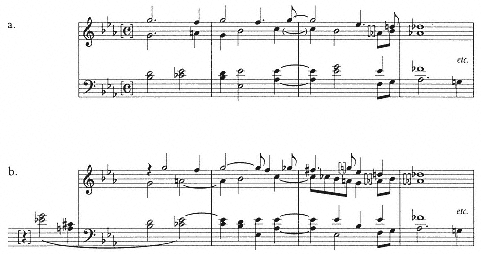
Example 8.12
First String Quartet, p. 7, sketches for second group, in Sketchbook I, p. 32.
what later, after Schoenberg had continued his conceptual path back through the exposition of the first movement.[18]
Schoenberg now abandoned the second group to work on the transition. First he jotted down in a very light pencil the scherzo theme itself, in triple meter and still (by implication) in the key of

[19] A similar phenomenon is to be found in the sketches for the First Chamber Symphony, op. 9, in Sketchbook II. In the midst of sketches for the development section, Schoenberg wrote out the first two measures of the secondary theme of the exposition (mm. 84-85). Schmidt suggests plausibly that this jotting represents an aide-mémoire (Gedächtnisstütze), since the head motive of this theme plays an important role in this particular passage of the development (SW B11/II: 65).

Example 8.13
First String Quartet, op. 7, sketch for transition theme, in Sketchbook I, p. 32.

Example 8.14
First String Quartet, op. 7, sketch for motive b, in Sketchbook I, p. 33.
and in something like the chromatic form it would assume in the transition. Motive b, however, still ascends by whole step,

On the next page of the sketchbook, I/33, Schoenberg began to sketch the transition in earnest by separating and actually labeling the component parts of the transformed scherzo theme, a, b, and c.[21] At the upper left of the page, we find motive b isolated (ex. 8.14; SW B20: 44 [S24]). This is very much like the b subject of the actual transition, beginning within the syncopation and the downward leap of a diminished fifth. But in the disjunct leaps of the continuation (


On the remainder of this page, we see the "cerebral" Schoenberg trying out various three-part combinations of the motives in four more short sketches.[22] At
[20] In S19, Schmidt mistakenly interprets the E in m. 4 of the sketch as a natural; the accidental preceding it is clearly a flat.
[21] A facsimile reproduction of this page appears in Frisch 1988a, 301.
[22] For transcriptions of these sketches, see SW B20: 45-48. Related sketching activity for the transition-in which Schoenberg tries out various combinations of the motives labeled a, b, and c,- is found on two loose leaves and in a pocket sketchbook, which must have been used concurrently with Sketchbook I. These sketches are transcribed in SW B20: 44-51. In one sketch (S134), Schoenberg wrote out the scherzo theme in its original form, apparently again as an aide-mémoire.

Example 8.15
First String Quartet, op. 7, sketch for transition, in Sketchbook I, p. 33.
some point during, or soon after, his work on this page—that is, after isolating motive b— Schoenberg turned back to 1/32 and added the syncopated measure in the margin for the bass part of the second theme (above, ex. 8.12). He thus tightened the net of thematic associations between this theme, the transition, and the scherzo still further. He also confirmed the final form of motive b, with ascending semitones (here

In his critical and theoretical writings Schoenberg often stresses that a motivic or thematic idea must have generative power—that all the events of a piece must be implicit in, or foreseen in, the basic shape, or Grundgestalt, presented at the opening.[23] In some of the exercises in his textbook Fundamentals of Musical Composition, he shows student composers how to elaborate an initial motive into an entire small work (Schoenberg 1967, 64-67). The transition, second group, development, and scherzo of the D-Minor Quartet can be heard as an extremely sophisticated example of this process on a massive scale. But the series of sketch pages (I/31-33) we have just examined suggests that the hearing and the making were hardly as congruent as Schoenberg's textbook (or his own statements on the creative process) might suggest. The "basic shape" from which Schoenberg forged this particular complex of thematic material was the scherzo theme. The
[23] See, for example, his remarks in the essay "Linear Counterpoint," where he postulates:" 'Whatever happens in a piece of music is nothing but the endless reshaping of a basic shape.' Or, in other words, there is nothing in a piece of music but what comes from the theme, springs from it and can be traced back to it; to put it still more severely, nothing but the theme itself. Or, all the shapes appearing in a piece of music are foreseen in the 'theme'" (Schoenberg 1975, 290).
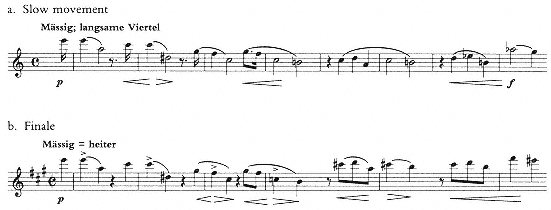
Example 8.16
First String Quartet, op. 7.
compositional process appears to have involved a gradual chromaticization of a diatonic scherzo theme into the transition theme—a process that is then reversed in the actual quartet, where the scherzo is made to serve as the culmination, rather than the germination.
With these three pages of concept sketches, Schoenberg resolved many of the problems of creating a thematically integrated and continuous form. He now returned to the first group and, on I/34-II/16, wrote out an extensive and more or less continuous draft of the entire first half of the quartet, through the trio. The matter of thematic and formal logic arose again, however, as Schoenberg planned the second half of the quartet. As table 9 suggests, the steady flow of composition came to a halt on II/16, at the beginning of the passage that was to serve as both scherzo recapitulation and second development. Schoenberg had here to reconcile two demands: that of the larger sonata-form design, which necessitated the further development of earlier material, and that of the individual movement, which required a symmetrical restatement of the scherzo theme.
He also began to think—or at least set down the first evidence of that thinking—about the shape that the latter part of the quartet would take. Here as well there were potentially conflicting demands. A slow movement and finale had to have sufficient independence as movements; yet to fulfill their role in the larger sonata-form design, they had also to recapitulate earlier material. Schoenberg's ultimate answer was to fashion the main theme of the slow movement of op. 7 (ex. 8.16a) as essentially new material. Unlike the scherzo, it does not grow out of or emerge from any obvious thematic process. Indeed, the slow movement comes as a distinct contrast or relaxation after the recapitulation and intense liquidation of the first theme. The main theme of the finale is virtually a Lisztian
transformation of the slow movement, whose first six measures are taken over note for note (ex. 8.16b).
This ingenious formal and thematic design was anything but obvious to Schoenberg when he was at II/18 of the sketches, as he broke off a tentative attempt at the scherzo recapitulation to draft a slow movement (see ex. 8.17; the sketch is fully transcribed in SW B20: 78-79 [S75]). This fragment, in the key of






Schoenberg's mind turned now to the last movement. Directly beneath this slow movement fragment, we find the first sketches for the finale theme. There are three, one above the other (excerpted in 8.18a, b, c; SW B20: 87-88 [S77-79]). The first, in A major, has lithe, energetic eighth notes. The second, still in A, slows down the motion and eliminates the melodic diminution; the theme now has also the beginnings of an accompaniment. The third sketch transposes the second to D major, the tonic of the work as a whole. In ex. 8.18b and c, the theme is quite close to its final form, except for the contour of the opening three-note figure, which here is a transformation of motive b, a descending leap followed by a chromatic ascent. As in the preceding draft of the slow movement, then, Schoenberg was deriving his thematic material exclusively (and audibly) from the first movement of the quartet. But this logical chain of thematic associations did not satisfy him. Indeed, he may have felt that he had linked that chain too tightly, that his quartet lacked enough genuine contrast.
He broke off these concept sketches for the finale and, on the next page, II/21, began a draft in full score of the slow movement as we now know it. Its theme is clearly related to the finale theme just sketched, but any direct association with motive b has been eliminated. The opening three-note figure now repeats the first note and leaps down a fifth. It is thus essentially new thematic material. When
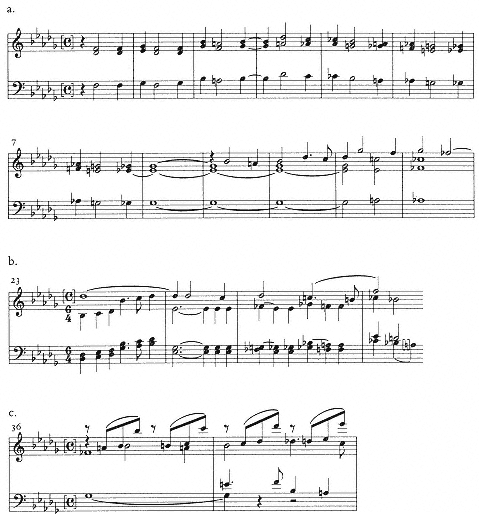
Example 8.17
First String Quartet, op. 7, draft for slow movement, in Sketchbook II, pp. 19–20 (reduction).
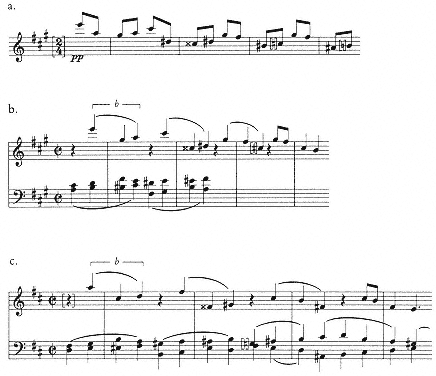
Example 8.18
First String Quartet, op. 7, sketches for finale theme, in Sketchbook II, p. 20.
Schoenberg came to write out the draft for the finale, beginning on II/42, he began to write the theme out as in ex. 8.18c, but then crossed out that version and rewrote the theme to bring it into conformity with the slow movement (see SW B20: 89-90 [S94]). As already demonstrated, the finale became an almost literal transformation of the slow movement.
Establishing this relationship between the slow movement and finale was, I believe, the last major conceptual problem Schoenberg encountered in planning the D-Minor Quartet.[24] He had found a way to give the second half of the quartet
[24] The autograph score of the quartet, however, is far from a clean copy. It contains numerous revisions, most notably large cuts in development 1 and recapitulation 1 (see SW B20: 101-9).
(the portion after the fermata) its own thematic integrity or identity without abandoning its purely recapitulatory function in the larger sonata design.
That Schoenberg decided to cast the finale theme in A major, and not in D, as in the third of the concept sketches (ex. 8.18c), is highly suggestive from the viewpoint of large-scale tonal planning. Very much as in Verklärte Nacht and Pelleas, he was faced in the latter part of the quartet with the challenge of reestablishing the tonic by means of the kind of dominant relationships that had been largely absent up to this point. One way of generating dominant tension was to place the rondo theme in the key of A.
In fact, however, in none of its three main appearances (indicated by A, A', and A" in movement IV of table 8) does the rondo theme resolve directly to the tonic. The magisterial coda of the quartet may be said to assert, rather than achieve, D major. The coda is certainly successful on its own terms, but its effect is different from a conclusion that grows out of extensive dominant preparation. One suspects that for Schoenberg, placing the rondo theme of op. 7 in the key of the dominant was something of a gesture toward a compositional procedure he no longer could or would easily follow. In the next chapter, we shall consider a very similar gesture, one that also seems to have generated uncertainty on the composer's part, in the B-major slow segment near the end of the First Chamber Symphony.
Schoenberg and Reger: A Brief Comparison
In chapter 1 it was suggested that among the younger Brahmsians of the 1890s, Max Reger came the closest to Schoenberg in his assimilation of and response to the compositional techniques of Brahms. By 1904 both composers had moved well beyond overt imitation or emulation; basic Brahmsian precepts, such as dense thematic-motivic development and flexible phrase structure, were now put in the service of highly individual chromatic languages. Yet there remain strong and instructive points of contact between the styles of Reger and Schoenberg. These are perhaps especially apparent in the string quartets in the same key, D minor, written by both composers at this time.
Reger's D-Minor Quartet, op. 74, completed and published in 1904, just as Schoenberg was working on his own op. 7, is one of his most imposing and ambitious pieces of chamber music, lasting almost an hour in performance.[25] It would be impossible to prove any direct impact of the Reger work upon Schoenberg, who at any rate began work on op. 7 before he could have encountered
[25] The timings given in Stein 1953, 139, total 58': I, 24'; II, 4'30"; III, 19'30"; IV, 10'.
Reger's work (which appeared in the summer of 1904). Yet during the protracted composition of his own op. 7, Schoenberg may well have become familiar with, and interested in, Reger's op. 74.
The circumstances are as follows. Reger's quartet was to have been premiered at the annual Tonkünstlerfest of the Allgemeiner Deutscher Musikverein in Frankfurt in May 1904, but because of the illness of one of the players, the performance was postponed until December in Frankfurt (Stein 1953, 608).[26] That same summer, Schoenberg and several Viennese colleagues formed the Vereinigung schaffender Tonkünstler (Society of Creative Composers) and were on the lookout for works to program in their first (and in the event, only) season. Reger himself joined the Vereinigung in July and agreed to participate as pianist (playing Bach transcriptions) in a concert on 20 February 1905.[27] As is apparent from the Vereinigung's concert program of 20 January 1905 (a copy is held at the Arnold Schoenberg Institute), plans were changed somewhat for the February concert, which was now announced to include the Reger D-Minor Quartet, op. 74. At the actual concert, however, the quartet was not performed; the Violin Sonata in C Major, op. 72, was substituted, played by Arnold Rosé and Bruno Walter. Reger himself was almost certainly present, as he was in Vienna on 19-20 February to participate in an all-Reger concert of the Ansorge-Verein (Schreiber 1981, 283).
It is well known that Schoenberg found much to admire in Reger's music. In 1918-21 he programmed numerous Reger works-indeed, more than by any other composer-in the concerts of the Society for Private Musical Performances (see Szmolyan 1981, 84-96); in his writings he would refer to Reger sympathetically (see, e.g., Schoenberg 1975, 129-30, 427). It is certainly possible that as Schoenberg resumed work on his quartet after a pause during the summer of 1904, and as he continued to labor over problems of large-scale structure in ways that we have examined above, Reger's op. 74, especially its first movement, provided a powerful model for the integration of sonata style and large-scale form.
Reger's movement, cast in sonata form without repeated exposition, and lasting nonetheless over twenty minutes, is surely one of the most massive composed at the turn of the century. Carl Dahlhaus has rightly characterized it as having "truly symphonic proportions" (Dahlhaus 1989, 339). Although it forms part of a piece of chamber music, the movement is really comparable in scope and duration to the sonata-form first movements of Mahler's Second, Sixth, and Sev-
[26] In the Schoenberg Collection at the Library of Congress there is an issue of the Mittheilungen of the Allegemeiner Deutscher Musikverein from May 1903, which announces Schoenberg as a new member of the society. There are also issues for August 1903 and for April and May 1904; the latter two announce the impending performance of the Reger quartet.
[27] Letters from Oskar Posa to Schoenberg, 12 July and 26 August 1904, Schoenberg Collection, Library of Congress.
enth Symphonies. In a contemporary assessment of Reger, the critic Max Hehemann suggested that the first movement of op. 74 stood as one of the composer's masterpieces because of its "exceedingly fecund invention both in the chiseled thematic working and the splendid architectonic structure" (Hehemann 1905, 416).
Like Schoenberg, Reger relies strongly on large and distinct thematic pillars to give definition to the sonata structure.[28] The design of Reger's expansive exposition can be represented as:
First group, D minor, mm. 1-68
theme 1a, m. 1
theme 1b, m. 6
1a, m. 10
1b, m. 15
1a, m. 29
transition, m. 34
1b, m. 49
1a, m. 55
Transition, mm. 69-90
Second theme, F major, mm. 91-116
Transition, mm. 117-38
Closing group,

Like many composers in the sonata tradition, Reger builds his large first group from two alternating and contrasting themes, but he greatly extends the process (to almost eight and a half minutes) and builds a considerable amount of variation and development into the thematic statements.
Reger's deployment and treatment of the 1a theme is similar to Schoenberg's in that the theme comes to represent a point of focus or orientation within the unfolding sonata form. Yet his developmental style is much less densely and continuously motivic than Schoenberg's. There is also much greater contrast between Reger's 1a and 1b than between Schoenberg's themes, which, as we have
[28] An extended analysis of the first movement of Reger's op. 74 is contained in Mattner 1985, 28-49. See also the motivic analysis in Wilke 1980, 170-76. Reger himself provided a brief commentary / analysis in the journal Die Musik (Reger 1904), intended to introduce the work before its projected premiere in Frankfurt.
seen, tend continuously to rework the opening material. Moreover, despite the rampant chromaticism, Reger's overall plan is more conservative than Schoenberg's. Schoenberg tends to avoid certain traditional harmonic relationships: in the first group of op. 7, D minor does not lead to, and is not often supported by, the dominant A major or the relative major F. Schoenberg prefers the more unusual

What Reger shares with Schoenberg—and what is, I think, rare among composers working in an advanced chromatic language and with larger instrumental forms at this time—is the ability to control broad spans with a fusion of harmonic tension, subtle phrase structure, and thematic construction. We have seen this on a small scale with Schoenberg's main theme; it is also readily apparent in the masterful second theme of Reger's movement (ex. 8.19). Reger's theme is wonderfully mobile in a way that seems quite close to the more homophonic segments of Schoenberg's quartet. The principal statement begins on F and moves at the halfway point to A minor (mm. 93-94). The second phrase concludes (or elides) in m. 99 on an





The two phrases of Reger's theme overlap in a fashion not unlike those of the main theme of Schoenberg's quartet. Phrase I concludes with a half-cadence to A minor (locally iii). This harmony is reached on the last half of m. 94, but the melody note at this point, D, is dissonant with the chord. In fact, the

The junction between the second phrase of the theme and the counterstatement of the first is treated in a similar fashion. The high



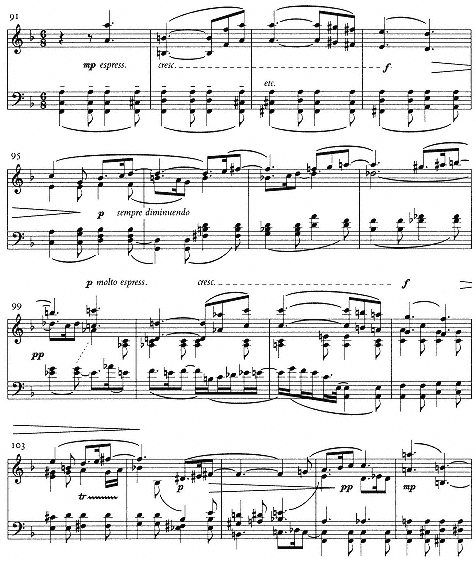
Example 8.19
Max Reger, String Quartet in D Minor, op. 74, I, second theme.
and Schoenberg display here, as in their youthful works, a profound affinity with these principles and an ability to transmute them into personal styles of great integrity.
After the D-Minor Quartet
The completion of the D-Minor Quartet was followed by a period of Lieder composition almost as intense as that of 1903-4. If the compositional energies of songs like Verlassen can be said to have been channeled into op. 7, those of the quartet itself seem to have flowed out into the group of songs from the fall of 1905, including Alles, op. 6, no. 2 (6 September 1905); Der Wanderer, op. 6, no. 8 (15 October); Am Wegrand, op. 6, no. 6 (18 October); Lockung, op. 6, no. 7 (26 October); and Mädchenlied, op. 6, no. 3 (28 October). Also drafted at this time was the fragmentary programmatic piano quintet, Ein Stelldichein, based on a Dehmel poem (published as Schoenberg 1980).[29]
Schoenberg claimed to have composed the Dehmel song Alles "very fast," while waiting for music paper with which to finish copying the D-Minor Quartet.[30] It is remarkable for its use of invertible counterpoint in the manner of op. 7 and for the extremely ambiguous tonal language, which settles into the tonic

Similar contrapuntal preoccupations are joined to a much more expressive language in Am Wegrand. The poem, by John Henry Mackay, which communicates alienation and despair in a manner not unlike Conradi's Verlassen, called forth an equally powerful response from Schoenberg. Am Wegrand shares the key of the quartet, D minor, and the wide-ranging, athletic opening melody of the voice seems cut from the same cloth as the main theme of op. 7. As in Verlassen, Alles, and the D-Minor Quartet, this melody forms part of a contapuntal complex that
[29] It has been claimed by Allen Forte (1978, 138) that "set consciousness"-that is, an intentional use of unordered pitch-class sets-begins for Schoenberg with the op. 6 songs composed in the fall of 1905. Forte bases his suggestion principally on what he analyzes as a frequent recurrence in the songs of Schoenberg's "musical signature," a six-note set made up of the pitch equivalents of letters from the composer's last name. Forte's analyses seem to me farfetched, in that to find the signature, he must often acknowledge complementation, transposition, and inversion of the set, atonal operations with which Schoenberg is not likely to have been acquainted at this time.
[30] See Newlin 1980, 63. Schoenberg does not mention Alles by name here, but it seems clear from the context of his remarks that he is referring to this song; there is no other song that corresponds in time to the final stages of the completion of the quartet in fall 1905.
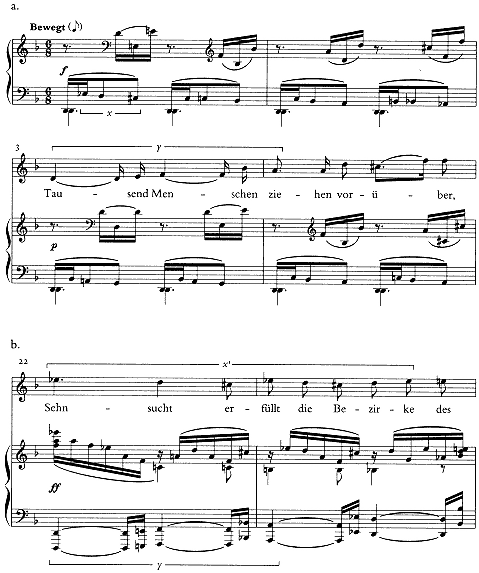
Example 8.20
Am Wegrand , op. 6, no. 6.
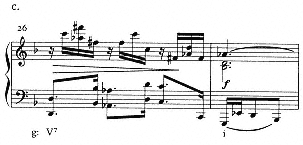
Example 8.20
continued
is subjected to inversion. From the three-note descending chromatic motive in the piano left hand (

Other similarities to the quartet are evident in Schoenberg's treatment of the main key. The opening bass motive, x, circumscribes the tonic D by semitone, a feature elaborated in the vocal version of the motive, x'. The upper half-step,



The introduction of the whole-tone complex in Am Wegrand is also related to procedures in op. 7.


Schoenberg's creative rhythm in the period 1903-6 seems to have dictated an alternation between Lieder and instrumental works. The achievements of the
songs of late 1905-the integration of whole-tone with diatonic-chromatic procedures in Am Wegrand; the contrapuntal intricacy of Alles; the "fluctuating" tonality, as Schoenberg called it, of Lockung, a song that "expresses an tonality without once in the course of the piece giving an triad in such a way that one could regard it as a pure tonic" (Schoenberg 1978, 383)-all these techniques were adumbrated to some degree in the D-Minor Quartet. They were to be carried over, in imaginative ways that Schoenberg himself could not have envisioned in 1905, into his next large-scale project, the First Chamber Symphony.